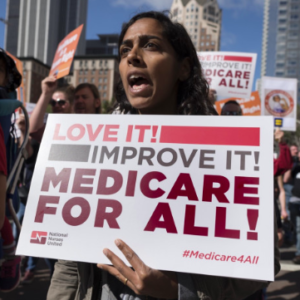At the first Democratic presidential debate, Americans heard yet more rosy talk of “Medicare for All.” Meanwhile, recently in Congress, the Democratic chairman of the House Ways and Means Committee held a hearing titled “Pathways to Universal Healthcare Coverage.” To no one’s surprise, Democrats filled the debate stage and committee room with lofty rhetoric, but in reality, proposals like “Medicare for All” would come with a bitter pill to swallow: socialized medicine in America.
Restrictions on access to care, economy and job-destroying taxes, and unprecedented deficit spending have never improved patients’ ability to get a timely diagnosis and effective treatments in moments of need.
Yet these realities have not stopped the far-left from chanting the new “Medicare for All” slogan and promoting it as the answer to America’s most pressing health care challenges. And along with Rep. Alexandria Ocasio-Cortez’s emerging “It’s Like, Free” caucus in Congress, they are now hoping to tap into voter anger over skyrocketing medical costs to achieve their broader political ends.
Far-left politicians know full well that, if armed with the facts, the vast majority of voters and patients would reject their plans outright. So the “It’s Like, Free” crowd, aided by an abetting national media, cloak their proposals in soft-sounding, inclusive and misleading names like “Medicare for All” — in reality, a $32 trillion utopian taxpayer-funded fantasy that would nationalize all U.S. medical care.
It would do so by eliminating the current insurance of hundreds of millions of Americans and consolidating all government programs into one massive, centrally administered federal health care Death Star. They would then tax individuals, families, small businesses and large employers out of livable existence. Just imagine how an honest explanation might be received by voters at a town hall in middle America:
“OK, ‘Medicare for All’ eliminates all the employer-provided and private insurance plans covering 250 million Americans like you, eliminates all Medicare beneficiaries’ plans and zeroes out the Medicare trust fund, eliminates Medicaid for the poor and disabled, the military’s TRICARE and the VA’s health systems, the Children’s Health Insurance Plan (CHIP), and consolidates them into a giant, one-size-fits-all federal program that will be administered by unelected boards and federal bureaucrats in Washington, D.C.”
Decisions about what treatments, specialists or drugs will be made available to you and your family will be determined by bureaucrats rather than by you and your current doctors, and access to such services, and when you can receive them, will be based on limited resources in accordance with spending caps. And despite services being “free,” this program will cost American taxpayers an estimated $32 trillion and lead to more than 2 million lost jobs in the private sector. Any questions?
Here’s one: How will seniors react to paying into a plan their entire lives with the expectation they’ll get a benefit, only to see the government giving away the benefits they paid for to someone else?
Fortunately, President Trump will never allow “Medicare for All” to see the light of day in America under his watch. And the prospect of a potential president like Sen. Bernie Sanders, Sen. Kamala Harris or Sen. Cory Booker — who have never managed anyone beyond government employees who cannot be fired — nationalizing our entire health care system, roughly 20 percent of the U.S. economy, should give even the most ardent liberal pause.
While the U.S. health care system has significant problems — cost being foremost — would Americans really be willing to pay even more to wait two and a half months or more for an MRI like Canadians do? Do they want a system where patients leave ERs without ever seeing a doctor due to staff shortages, like in Britain, or a median wait for prostate cancer surgery of 120 days, like in Sweden?
And it’s not just the Democrats that Americans should be concerned with. Both Democrats and Republicans in Washington have recently offered an array of misguided legislative and regulatory proposals that could later serve as the foundation to build full-scale socialized medicine programs down the road. As is always the case, once codified into law, policies can easily be manipulated, expanded and tied together by executive order and regulatory fiat, and upheld by activist courts, down the road.
Ultimately, proposals like “Medicare for All” and other smaller proposals are costly, inefficient, inhumane and serve to upend the norms of doctor-patient relationships. Socialized medicine is not the cure; it is a debilitating human and economic disease and Americans would be wise to take notice of the hardships endured by other countries before it becomes a reality here at home.

